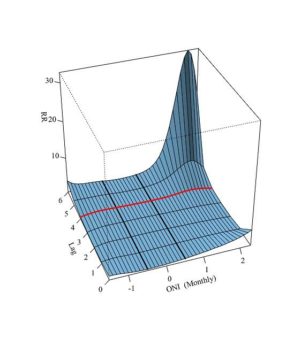- by Gary Finnegan
Dengue alert: scientists find natural warning system
Researchers in Sweden have identified a strong link between El Niño conditions in the Pacific and dengue fever epidemics in South Asia. The finding could help to improve epidemic warning lead times – giving health authorities time to prepare for major dengue outbreaks.
El Niño is associated with a band of warm ocean water that develops in the central and east-central equatorial Pacific. The new study looked at how this natural phenomenon influences rainfall and temperatures in Sri Lanka.
The El Niño, dengue connection
Weather is already known to influence the spread of mosquito-borne diseases so if El Niño works like an advance weather forecast, it could essentially serve as a long-range epidemic predictor.
“Dengue is the major public health burden in Sri Lanka and the Kalutara district is one of the most affected areas. So understanding how reoccurring weather patterns drive dengue is vital in controlling and preventing the disease spread,” says Joacim Rocklöv, a researcher at the Unit for Epidemiology and Global Health at Umeå University in Sweden and co-author of the article published in the International Journal of Environmental Research and Public Health.
“These new findings allow disease early warning systems to provide warnings for upcoming epidemics with much longer lead time than before,” says Prasad Liyanage, a doctoral student at Umeå University and Medical Officer for dengue control in Kalutara district at the Sri Lankan Ministry of Health.

A three-dimensional plot showing the exposure-lag-response association between Oceanic Niño index (ONI) and relative risk of dengue (RR) in Kalutara, Sri Lanka. When ONI increases to more than 0.5, the relative risk of dengue dramatically increases at a lag period of six months (see upper right corner). Image via Umeå University
In the study, researchers used the Oceanic Niño Index, which is a measure indicating el Niño activity by sea surface temperature in the Pacific Ocean, along with local weather and epidemiological data to quantify data associations in 10 healthcare divisions of Kalutara in southwestern Sri Lanka. Weekly weather variables and data on dengue notifications, gathered by Prasad Liyanage for the Ministry of Health between 2009 and 2013, were analyzed to estimate locally specific and overall relationships between weather and dengue.
The results showed an increasing relative risk of dengue with increasing rainfall starting at above 50 mm per week. The strongest association between rainfall and dengue was found around 6 to 10 weeks following rainfalls of more than 300 mm per week, which amounts to very wet conditions and floods. With increasing temperatures of 30 degrees Celsius or higher, the overall relative risk of dengue increased steadily starting from a lag of 4 weeks.
“Looking at weather and dengue incidents over longer periods, we found a similar strong link between how increased rainfall and warmer temperatures resulting from the reoccurring el Niño phenomenon are associated with elevated risks of dengue epidemics. In the longer perspective, our data further confirms this association and suggests that dengue fever thrives whenever el Niño visits our island,” says Prasad Liyanage.
Learn more: Understanding the impact of global warming on the spread of dengue
According to the researchers, the findings can be used to improve predictive surveillance models with lead times of up to six months. This would give health officials longer time to increase preparedness and mount control effort responses prior to the epidemics. Today, such control efforts usually have limited effects as they start when signs of an epidemic can be seen within the hospital and primary care surveillance system.
—
Help control dengue outbreaks. Report dengue activity from your smartphone using Dengue Track.

